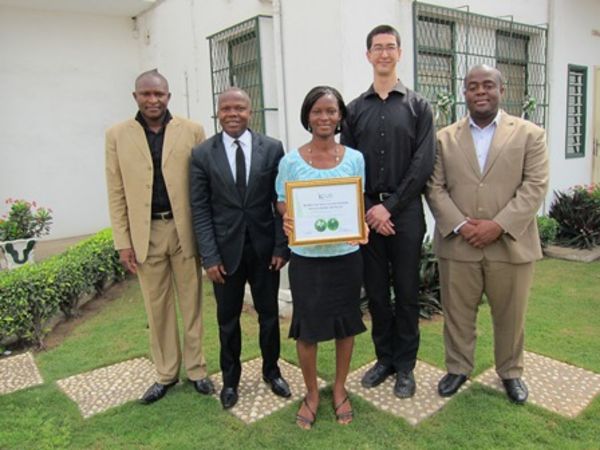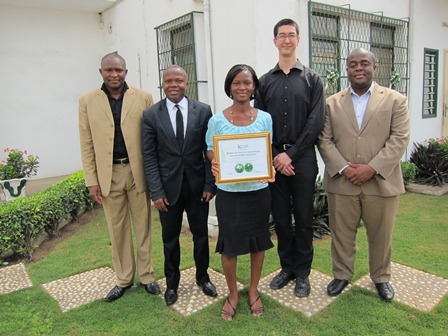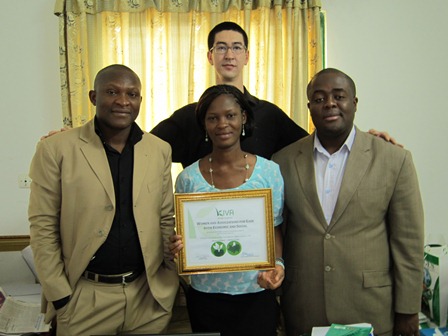The Sums of a Social Performance Certificate
March 4, 2012
Michael Slattery | KF 17 | Togo
Early on in my stay in Lomé I presented the Social Performance badge certificate awarded by Kiva to my microfinance institution WAGES. I made enquiries and had a gilded frame made for the certificate at a local photography shop, and presented it to the Director of Women and Associations for Gains for Economic and Social (WAGES), Monsieur NASSIROU Ramanou.

Here we are at WAGES' headquarters in central Lomé. From left to right is M. AFO Kossi, Program Director, then M. NASSIROU Ramanou, Director General of WAGES, M. HOFFER Carine, Kiva Coordinator, the author with Canadian winter tan, and M. ASSANI-BENTHO Nasser, Projects Manager.
The certificate reflects two badges awarded earlier this year, Entrepreneurial Support and Facilitation of Savings, which recognize the services provided to WAGES’ clients that have specific social-economic impact.
Entrepreneurial support translates into monthly training sessions offered to their clients with regards to business management practices and bookeeping basics; whereas Facilitation of Savings relates to microsavings accounts, where clients can make small daily deposits towards building up both personal savings as well as access to greater credit.
More generally, WAGES is a well-established microfinance institution (MFI) with seventeen branches in the country, most of these in Lomé.
Ignoring for the moment their status as a government registered MFI, the range of financial services they offer are similar to what a common commercial bank has on its menu, with such stalwarts as (micro)savings accounts, a variety of specifically geared (micro)credit offerings, and term deposits.

The immediate colleagues I work with on a daily basis, M. AFO Kossi, M. HOFFER Carine, and M. ASSANI-BENTHO Nasser. Photo credit: M. LAKOUSSAN, Parfait.
Yet even as I have opened a checking account with Ecobank in Lomé, one of Africa’s more well established commercial banks, I would not have been likely able to have done so with WAGES.
The reason for this is that WAGES’ vision is to “Become a perennial and model microfinance institution in Togo,” (“Devenir une institution de micro finance pérenne et modèle au Togo”) and moreover to participate in an active manner to the social-economic development of their client community, that is the lower end of the social-economic pyramid.
Indeed WAGES targets a majority female clientele, solidarity groups, associations, and also offers non-financial services like business and household accounting training, HIV/AIDS and malaria education, legal advice, managing income generating activities, as well as institutional support to developing or enhancing solidarity group constitutions and their group performance.
I do not fit this audience profile in any such way.
Also conspicuous is that this is not the operating ethos of the commercial bank. Working along the same line of thought, Kiva social performance badges could not have been awarded to Ecobank. Seen from afar, commercial banks and microfinance institutions are superficially similar in terms of achieving profit from interest, yet they serve a substantially different client base and have fundamentally different objectives.
Where commercial banks do not commonly tread is in social development; and if so it is only secondary to their financial services. On the other hand MFIs are socially conscious entities whose raison d´etre is social and economic, an interweaving of financial services for social gains in an under-serviced market.
That being said, in a well-known account of microfinance published in 2009, Portfolios of the Poor, the authors imply that the divide between microfinance institutions and conventional banks is not so great as might be supposed.
“A fundamental but easily overlooked lesson from the diaries is that the demand for microcredit extends well beyond the need for just microentreprise credit. The poor households in the study seek loans for a multitude of uses besides business investment: to cope with emergencies, acquire household assets, pay schooling and health fees, and, in general, to better manage complicated lives” (p. 25).
This conclusion stems from how a group of Bangladeshi borrowers studied were discovered to have used their loans. Along with investing in their businesses, it turns out that these clients used their loans for purposes beyond those they listed when requesting the loan, be it to pay off other debt, to purchase food for consumption; lend money themselves, or for other household costs (pp. 165-167).
As concluded, “The most striking finding of this brief review is the diversity of uses on display; set against the concentration of some uses among distinct types of users. On the one hand; it is clear that an early hope of microfinance lending—that virtually every loan would be invested in a microenterprise—has not come about. On the other hand; businesses and asset-investment uses are responsible for more than half the value of loans disbursed; though concentrated among the minority of borrowers well placed to use them this way” (p. 167).
Said otherwise, a well-positioned minority of the borrowers studied used over half of their loans for their businesses and the rest for other purposes.
While this may at first seem shocking, I don’t feel that this revelation is unusual; more importantly, neither do the expert authors. Their point is that microfinance borrowers have complex financial lives, as complex if not more so than those who are better off:
“When incomes are small, tools to manage income well become vitally important. The money that the poor earn too often arrives at the wrong times, can be hard to hold onto, and is difficult to build into something larger through borrowing and saving. This is the fundamental tragedy of poverty as seen through a financial lens: the triple whammy of incomes that are both low and uncertain, within contexts where the financial opportunities to leverage and smooth income to fit expenditures are extremely limited” (p.175).
Evidently microloans provide access to useful, relatively large, sums of money that would otherwise require a large amount of time to acquire. The other microfinancial services offered–microsavings and training, for example–are the tools that help manage income.
These useful sums then flow into the complex household budget that the poor maintain, increasing their ability to both invest in their enterprises, as well as stabilize their finances against the uncertainty created by tight cash flow. Investing in their businesses is just one part of their expenditures, and being able to fill various pot holes in their budget makes them better able to do their business–otherwise stated as ‘smoothing’ their income stream, making their lives easier to plan and provide for.
This concept is one that is easily appreciated by an entrepreneur in any part of the world; a line of credit at the right time can allow for not only business security and growth, but also peace of mind for the other aspects of life that incur costs.
Mixed use of a loan is however a double-edged sword. If too much of the loan is invested in non-business aspects that do not bring return on investment, like rent for example, then quickly clients can not keep up with repayments, as it has been described to me variously by the loan officers at WAGES.
Part of the duties of an MFI–and by extension its loan officers–is thus to ensure that its clients do not stray from their declared financial intentions, be it through business training, microsavings opportunities or strictly enforced rules on credit use. Such is the variance from commercial banking, and part of the greater formula that contributes to the sums of social performance.
Michael Slattery (KF17) is serving as a Kiva Fellow with WAGES in Lomé, Togo. Find a borrower and lend today!
PREVIOUS ARTICLE
Week in Review: Let’s talk about women →NEXT ARTICLE
Micro-Credit’s Dirty Little Secret →













